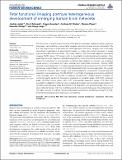Fetal functional imaging portrays heterogeneous development of emerging human brain networks
Author(s)
Jakab, András; Schwartz, Ernst; Kasprian, Gregor; Gruber, Gerlinde M.; Prayer, Daniela; Schöpf, Veronika; Langs, Georg; ... Show more Show less
DownloadJakab-2014-Fetal functional ima.pdf (4.287Mb)
PUBLISHER_CC
Publisher with Creative Commons License
Creative Commons Attribution
Terms of use
Metadata
Show full item recordAbstract
The functional connectivity architecture of the adult human brain enables complex cognitive processes, and exhibits a remarkably complex structure shared across individuals. We are only beginning to understand its heterogeneous structure, ranging from a strongly hierarchical organization in sensorimotor areas to widely distributed networks in areas such as the parieto-frontal cortex. Our study relied on the functional magnetic resonance imaging (fMRI) data of 32 fetuses with no detectable morphological abnormalities. After adapting functional magnetic resonance acquisition, motion correction, and nuisance signal reduction procedures of resting-state functional data analysis to fetuses, we extracted neural activity information for major cortical and subcortical structures. Resting fMRI networks were observed for increasing regional functional connectivity from 21st to 38th gestational weeks (GWs) with a network-based statistical inference approach. The overall connectivity network, short range, and interhemispheric connections showed sigmoid expansion curve peaking at the 26–29 GW. In contrast, long-range connections exhibited linear increase with no periods of peaking development. Region-specific increase of functional signal synchrony followed a sequence of occipital (peak: 24.8 GW), temporal (peak: 26 GW), frontal (peak: 26.4 GW), and parietal expansion (peak: 27.5 GW). We successfully adapted functional neuroimaging and image post-processing approaches to correlate macroscopical scale activations in the fetal brain with gestational age. This in vivo study reflects the fact that the mid-fetal period hosts events that cause the architecture of the brain circuitry to mature, which presumably manifests in increasing strength of intra- and interhemispheric functional macro connectivity.
Date issued
2014-10Department
Massachusetts Institute of Technology. Computer Science and Artificial Intelligence LaboratoryJournal
Frontiers in Human Neuroscience
Publisher
Frontiers Research Foundation
Citation
Jakab, András, Ernst Schwartz, Gregor Kasprian, Gerlinde M. Gruber, Daniela Prayer, Veronika Schöpf, and Georg Langs. “Fetal Functional Imaging Portrays Heterogeneous Development of Emerging Human Brain Networks.” Frontiers in Human Neuroscience 8 (October 22, 2014).
Version: Final published version
ISSN
1662-5161